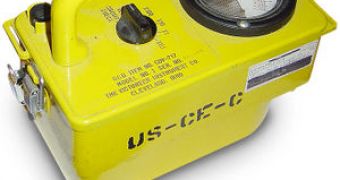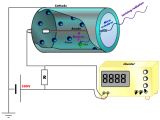The Geiger-Muller counter is a particle detector designed to detect ionizing radiation, such as alpha and beta as well as gamma radiation (although with significantly lower sensitivity than other types of detectors). It was invented by the German physicist Hans Geiger (co-discoverer of the atom nucleus) and later improved by his student Walther Muller, therefore the name Geiger-Muller counter. It is probably one of the most famous radiation detectors, mostly due to its simplicity and the distinctive audible clicks produced with the detection of individual particles.
Alternatively, except for its use in the detection of ionizing radiation, the Geiger counter is also used as a random number generator.
The main element of a Geiger counter is the Geiger-Muller tube, which is basically a chamber filled with inert gas or a mix of organic vapor and halogens. The tube contains two electrodes, the anode and the cathode, which are usually coated with graphite. The anode is represented by a wire in the center of the cylindrical chamber while the cathode forms the lateral area. One end of the cylinder, through which the radiation enters the chamber, is sealed by a mica window.
As ionizing radiation coming from the surrounding medium passes through the mica window and enters the Geiger-Muller tube, it ionizes the gas inside, transforming it into positively charged ions and electrons. The electrons eventually migrate towards the anode of the tube detector, while the positively charged ions accelerate towards the cathode. As the positive ions move towards the cathode, they collide with the remaining inert gas thus producing more ions through an avalanche effect. When this happens an electrical current is established between the two electrodes.
This current can then be easily collected, amplified and measured or counted and played in the form of an acoustic signal made out of clicks (available for most Geiger-Muller counters), each of which should correspond to the detection of a single ion (most of the times prevented by secondary avalanche processes). To improve the detection, multiple discharge stopping techniques can be used, either by removing the high voltage from the electrodes or by inserting additional organic or halogen gases in the inert mix.
Mica is generally preferred in the construction of Geiger-Muller tubes mostly because it is able to detect alpha particles, as opposed to glass, but it is also much more fragile than glass and can be easily damaged. Although it is said that Geiger counters detect ionizing radiation, most of them are not sensitive to neutrons. Nevertheless, the Geiger-Muller tube can be modified accordingly by coating it with boron or by using boron trifluoride gas or helium-3.

 14 DAY TRIAL //
14 DAY TRIAL // 
